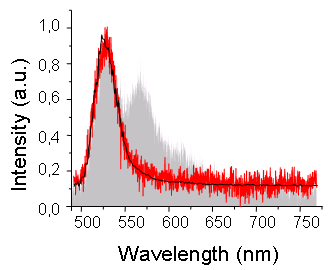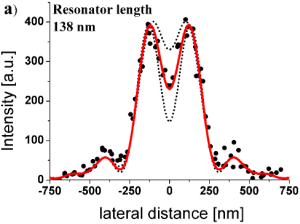Single molecules in a tunable microresonator
| Placing a single molecule between two resonator mirrors in the range of half a wavelength drastically changes its emission properties. The fluorescence emission of the single molecule in free space (grey shaded area) is confined in the microresonator (red line) due to coupling to the cavity resonances. Tuning the mirror distance changes the cavities resonance and thus also modifies the fluorescent spectrum ([62]). The microresonator also modifies the lifetime of the embedded emitter resulting in an enhancement or inhibition of the spontaneous emission rate (Purcell effect). |  |
| We also developed a method to determine the exact longitudinal position of a fluorescent bead between the resonator mirrors using a radially polarized doughnut mode laser beam. The microresonator changes the excitation field distribution with respect to the free space focus resulting in an excitation pattern that has qualitatively distinct features in different parts of the resonator [56]. By analyzing the experimental patterns resulting from the illumination of a single fluorescent bead we can determine its longitudinal position with an accuracy of /60. The red line shows a fit to the experimental pattern (black dots) whilst the dotted lines are calculated for a deviation of 5 nm from the optimum position [61]. |  |
